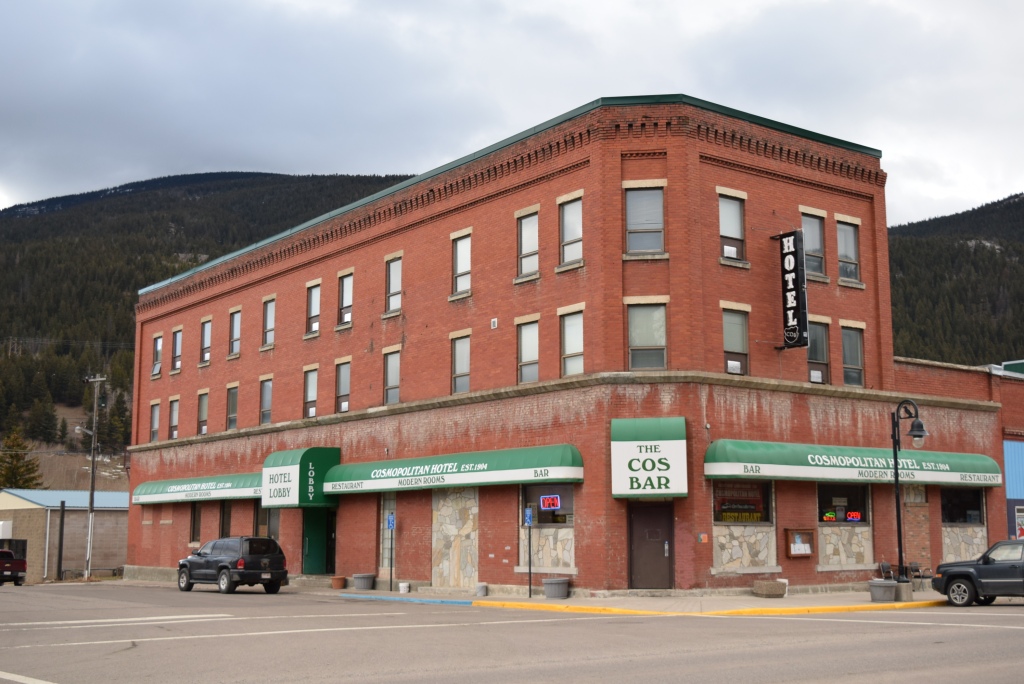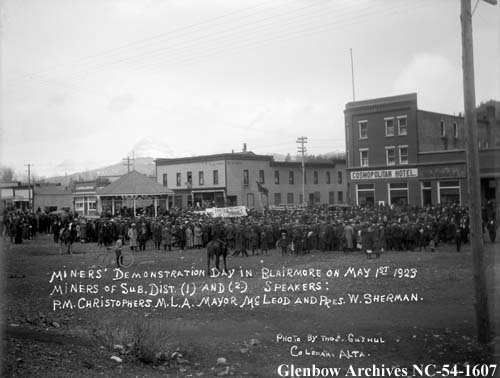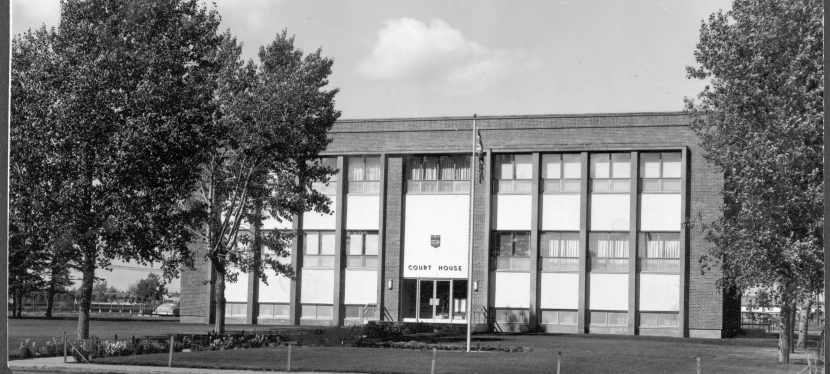Editor’s note: Read previous RETROactive posts about Historic Resource designation.
Written by: Ronald Kelland, Historic Places Research and Designation Program
Recently, some new Municipal Historic Designations in the Crowsnest Pass, Trochu and Grande Prairie have been added to the Alberta Register of Historic Places. These resources have been deemed by their municipality to be of significant heritage value to their community. Like Provincial Historic Resources, municipally designated properties are protected under the Historical Resources Act and qualify for conservation grants from the Heritage Preservation Partnership Program.
Cosmopolitan Hotel (Crowsnest Pass – Blairmore)
The Cosmopolitan Hotel is a three-story brick building. Its heritage value lies in its: association with the urban and commercial development of the former mining town; for its design; and for its position as a community landmark. Like many communities in their early days, Blairmore’s earliest buildings were simple, wood-frame structures, which were highly susceptible to fire. The original, wood-frame Cosmopolitan Hotel burned down in 1912, along with much of Blairmore’s commercial district. The hotel was rebuilt as a substantial, 50-room brick structure later that same year.
Although still a simple and understated structure, it affects an impressively solid appearance and has some ornamental details, such as the corbelled parapet that were common on commercial buildings of the period. Located on a corner lot on what was Blairmore’s most important intersection, the Cosmopolitan Hotel has long been a significant landmark in the Crowsnest Pass. Being located across the street from the Blairmore Bandstand, which was a favoured location for community events, miners’ union rallies and strikes, the Cosmopolitan Hotel was often the backdrop of those events, making it a significant focal point for the community.
The Cosmopolitan Hotel was designated as a Municipal Historic Resource in 2016 and was listed on the Alberta Register of Historic Places in early 2024.


Peuchen Block (Crowsnest Pass – Blairmore)
The Peuchen Block is a two-story, brick Commercial Edwardian building on Blairmore’s main commercial street. Its heritage value lies in its architectural significance and its association with several significant people in the town’s early development. It was one of the earliest brick structures in the community, and its presence in the streetscape made a statement about the expectations of a promising future for Blairmore. The Peuchen Block was built in 1911 by W.J. Budd, a significant developer, who had established cement plants across Alberta, in Calgary, Blairmore and Marlboro (west of Edson).
The building is named for Lt. Col. Arthur Godfrey Peuchen of Toronto. Peuchen, a former military man was also a chemist and president of Standard Chemical and the Iron & Lumber Company of Canada. Peuchen also survived the Titanic sinking. It is believed that Peuchen may have financed the construction of the building. Significant later owners or tenants of the Peuchen Block include: Louis Dutil, long-time owner of the Baltimore Hardware store; school board and Board of Trade member and councillor on Blairmore’s first town council; and the Kubok Family, who were significant local businesspeople who operated stores in the building for more than 50 years.
The Peuchen Block was designated as a Municipal Historic Resource in 2013 and was listed on the Alberta Register of Historic Places in early 2024.
The listing of the Cosmopolitan Hotel and the Peuchen Block on the Alberta Register of Historic Places brings the number of Municipal Historic Places in the Crowsnest Pass to four, all located in the community of Blairmore, joining the 10 Provincial Historic Resources located in the Crowsnest Pass.

Dr. Hay House (Trochu)
Located in the Trochu Arboretum and Gardens on the northern edge of the Town of Trochu, the Dr. Hay House is significant for its Craftsman design and its association with Dr. Andrew James Stewart Hay. The Craftsman style was an American residential design style that grew out of the English Arts and Crafts movement, which was a reaction to the Industrial Revolution and mass-production. Focusing on natural materials and hand-crafted elements, it was a fashionable style of home in Alberta during the 1910s and 1920s.
Dr. Andrew Hay was a prominent and beloved medical doctor in Trochu. Born in Medicine Hat in June 1914, he spent his teenage years in Stettler. He trained as a teacher at the Calgary Normal School and taught at a rural school near Gadsby. In 1936, he entered the medical school at the University of Alberta, where he convocated in 1942 and served overseas with the Canadian Army Medical Corps during the Second World War. He settled in Trochu in 1946 where he worked at the St. Mary’s Hospital and established a medical practice. He never owned a car or telephone, instead walking through town to make house calls and arranged rides to visit patients through the surrounding district. Dr. Hay died on May 30, 1973, and an estimated 700 people attended his funeral. He was also an avid gardener and naturalist. When the Alberta Heritage Survey documented the site in 1981, the house was seeing only occasionally use and was starting to fall into disrepair. However, even then, the Heritage Survey photographer noted that when in bloom, the gardens surrounding the house were truly beautiful. The house, now restored and surrounded by the Trochu Arboretum and Gardens, is a fitting memorial to this well-regarded and dedicated town doctor.
The Town of Trochu designated the Hay House as a Municipal Historic Resource in May 2022 and it was listed on the Alberta Register of Historic Places in early 2024. It is the first municipal designation in Trochu and joins the nearby St. Ann Ranch Provincial Historic Resource.


Grande Prairie Courthouse (Grande Prairie)
Located at the corner of 99 Street and 101 Avenue in Grande Prairie, the Grande Prairie Courthouse is significant for its association with Alberta’s court system, as an example of public building architecture and as a local landmark. The courthouse was built in 1957 and served a district that stretched from Valleyview west to the Alberta-British Columbia boundary, and the Wapiti River in the south to the Peace River in the north. Population growth of Grande Prairie and the surrounding region meant that larger facilities were needed for the administration of justice.
At the same time, preferences in architecture for public buildings was evolving from the revivalist styles of the early 1900s to more modern styles. The Grande Prairie Courthouse exhibits a distinctly modern appearance, with a general lack of ornamentation and emphasis on strong vertical and horizontal lines. While not identical, the Grande Prairie Courthouse bears striking similarity to the Drumheller Courthouse (Provincial Historic Resource), which had been built three years earlier, and the Government of Canada Building (Provincial Historic Resource) in Red Deer (built in 1951), which, though built by a different level of government, shares similar design principles. Being the location of the new courthouse further solidified Grande Prairie’s position as the primary hub for much of northwestern Alberta and, being located at a prominent downtown intersection, the courthouse has been a focal point of the community since its construction. The building’s use as a courthouse ended in 1984 and the site is now the home of a community arts centre.
The City of Grande Prairie designated the courthouse as a Municipal Historic Resource in March 2016 and it was listed on the Alberta Register of Historic Places in early 2024. It is the first Municipal Historic Resource in Grande Prairie to be listed on the Register and joins two Provincial Historic Resources – Grande Prairie High School and the Reverend Forbes Homestead – on the Register.






Tara, Just a couple of days ago I signed up to get news from RETROactive. This is the first I rec’d since doing so. I thought it might interest you because you may recognize the places mentioned in Blairmore. Love from Dad